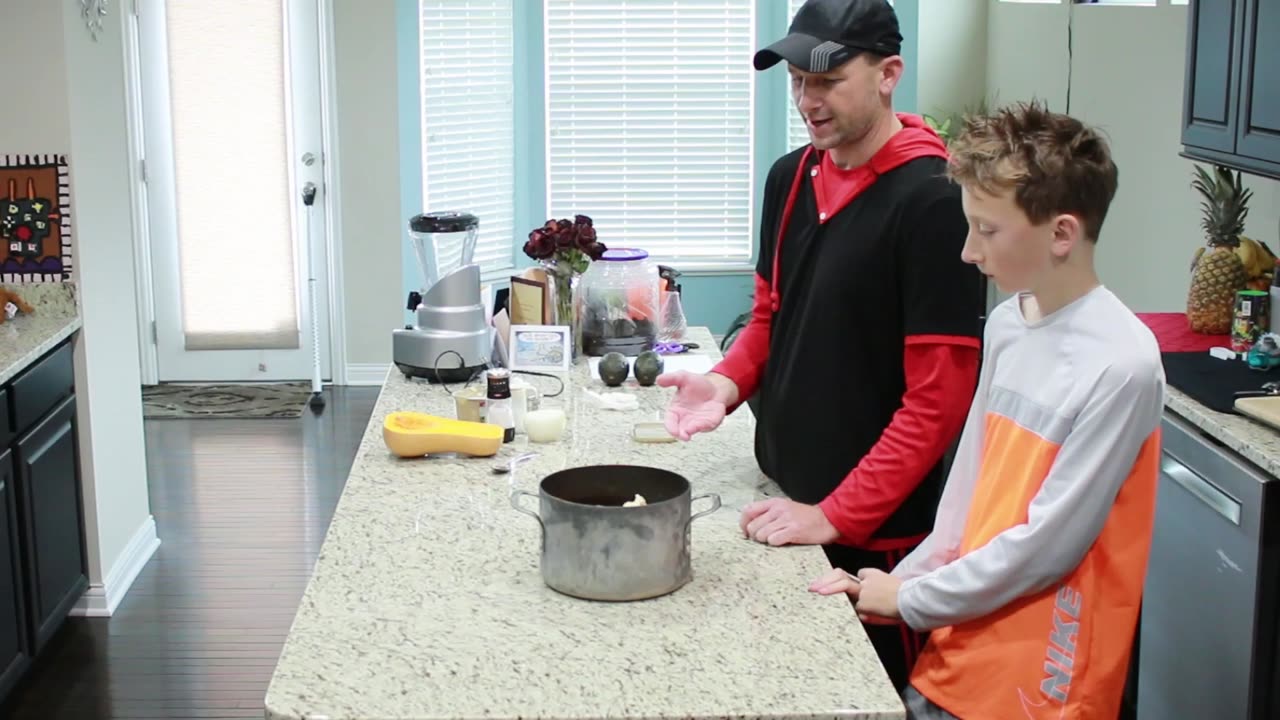Premium Only Content

Butternut Squash Soup Recipe. Simple Recipe Cooking Steps Walk Through How to Prepare.
At IHUCT we not only like to discuss inspirational topics but like to bring you some of our cooking tips. We love to share these exciting adventures and helpful tips with our viewers. Today we are sharing our Butternut Squash Soup Recipe. We hope you enjoy. Let us know what your favorite dish is and or what you would like us to cook in our next segment.
Be sure to share with us some links to videos you have created where you share amazing dishes you have made! We'd love to share that with everyone! Also, let us know what fun activities and traditions your families enjoy to create cherished memories!
Also, don’t forget to check out Inspiring How UC That on our other platforms:
Website links: www.IHUCT.org
www.inspiringhowucthat.org
Facebook: https://www.facebook.com/inspiringhowUCthat
Instagram: https://www.instagram.com/inspiringhowucthat/
E-mail: inspiringhowucthat@gmail.com
To follow Gavin's awesome gaming channel, visit:
https://www.youtube.com/c/GavinaGoodTime
Also Gavin's Etzy store:
https://www.etsy.com/shop/Gavinagoodtime44?ref=seller-platform-mcnav
#butternutsquashsoup #butternutsquash #souprecipe #cookingchannel #cookingtips #mealprep #thanksgivingrecipes #pierecipes #cherrypierecipe #cookingvideo #homemadecherrypie #fatherandsonactivities #familyrecipe #gavinagoodtime #inspiringhowucthat #cherrypie #deliciousrecipe
Butternut squash (Cucurbita moschata), known in Australia and New Zealand as butternut pumpkin or gramma, is a type of winter squash that grows on a vine. It has a sweet, nutty taste similar to that of a pumpkin. It has tan-yellow skin and orange fleshy pulp with a compartment of seeds in the blossom end. When ripe, it turns increasingly deep orange, and becomes sweeter and richer. It is a good source of fiber, vitamin C, magnesium, and potassium; and it is a source of vitamin A.
Although botanically a fruit (specifically, a berry), butternut squash is used culinarily as a vegetable that can be roasted, sautéed, toasted, puréed for soups such as squash soup, or mashed to be used in casseroles, breads, muffins, and pies. It is part of the same squash family as ponca, waltham, pumpkin, and calabaza.
Butternut squash will store for two to three months. Some varieties will keep up to six months. They are best kept at 10 °C (50 °F) with 50 percent humidity. For the best flavor, butternut squash should be left to cure for 2 months after harvest.
Nutrition
Butternut squash growing in a garden in Oklahoma
Raw butternut squash is 86% water, 12% carbohydrates, 1% protein, and contains negligible fat (table). A 100-gram reference amount supplies 188 kilojoules (45 kilocalories) of food energy, is a rich source (20% or more of the Daily Value, DV) of vitamin A (67% DV) and vitamin C (25% DV), and contains moderate amounts of vitamin B6, vitamin E, magnesium, and manganese, each having content of 10–12% DV.
Culinary uses
One of the most common ways to prepare butternut squash is roasting. Once roasted, it can be eaten in a variety of ways. The fruit is prepared by removing the skin, stalk, and seeds, which are not usually eaten or cooked. However, the seeds are edible, either raw or roasted, and the skin is also edible and softens when roasted. The seeds can even be roasted and pressed into an oil to create butternut squash seed oil. This oil can be used for roasting, cooking, on popcorn, or as a salad dressing.
In Australia, it is regarded as a pumpkin, and is used interchangeably with other types of pumpkin.
In South Africa, butternut squash is commonly used and often prepared as a soup or grilled whole. Grilled butternut is typically seasoned with nutmeg and cinnamon or stuffed (e.g., spinach and feta) before being wrapped in foil and grilled. Grilled butternut is often served as a side dish to braais (barbecues) and the soup as a starter dish.
Butternuts were introduced commercially in New Zealand in the 1950s by brothers Arthur and David Harrison, nursery workers, and Otaki market gardeners.
Credit to Wiki:
*Copyright Disclaimer Under Section 107 of the Copyright Act 1976, allowance is made for "fair use" for purposes such as criticism, comment, news reporting, teaching, scholarship, and research. Fair use is a use permitted by copyright statute that might otherwise be infringing. Non-profit, educational or personal use tips the balance in favor of fair use. No copyright infringement intended. ALL RIGHTS BELONG TO THEIR RESPECTIVE OWNERS*
-
 8:15
8:15
Inspiring How UC That
2 years ago $0.06 earnedFavorite Guitarists - Top 10; Featuring Eddie Van Halen, Nita Straus, Matthew Yost, and More
194 -
 LIVE
LIVE
Bannons War Room
5 months agoWarRoom Live
14,766 watching -
 LIVE
LIVE
Badlands Media
7 hours agoBadlands Daily: July 24, 2025
4,608 watching -
 1:09:41
1:09:41
Dear America
2 hours agoBOMBSHELL!! Hillary Was on Tranquilizers!! AND The Clintons Are Being Subpoenaed Over Epstein!!
115K54 -
 LIVE
LIVE
Benny Johnson
44 minutes ago🚨US House Votes to SUBPOENA Bill and Hillary Clinton Over Epstein | DOJ Meeting Maxwell Right NOW
5,262 watching -
 LIVE
LIVE
Matt Kohrs
10 hours agoStocks Push New Highs, Breaking Market News & Live Trading $1M w/ AI
773 watching -
 LIVE
LIVE
Wendy Bell Radio
6 hours agoNo One Is Above The Law
9,768 watching -
 LIVE
LIVE
LFA TV
13 hours agoLFA TV ALL DAY STREAM - THURSDAY 7/24/25
3,413 watching -
 LIVE
LIVE
StoneMountain64
1 hour agoBattlefield 6 Trailer REVEAL
110 watching -
 34:19
34:19
The Official Corbett Report Rumble Channel
11 hours agoThe Blueprint for AI Government Revealed with Jacob Nordangård
3.82K7